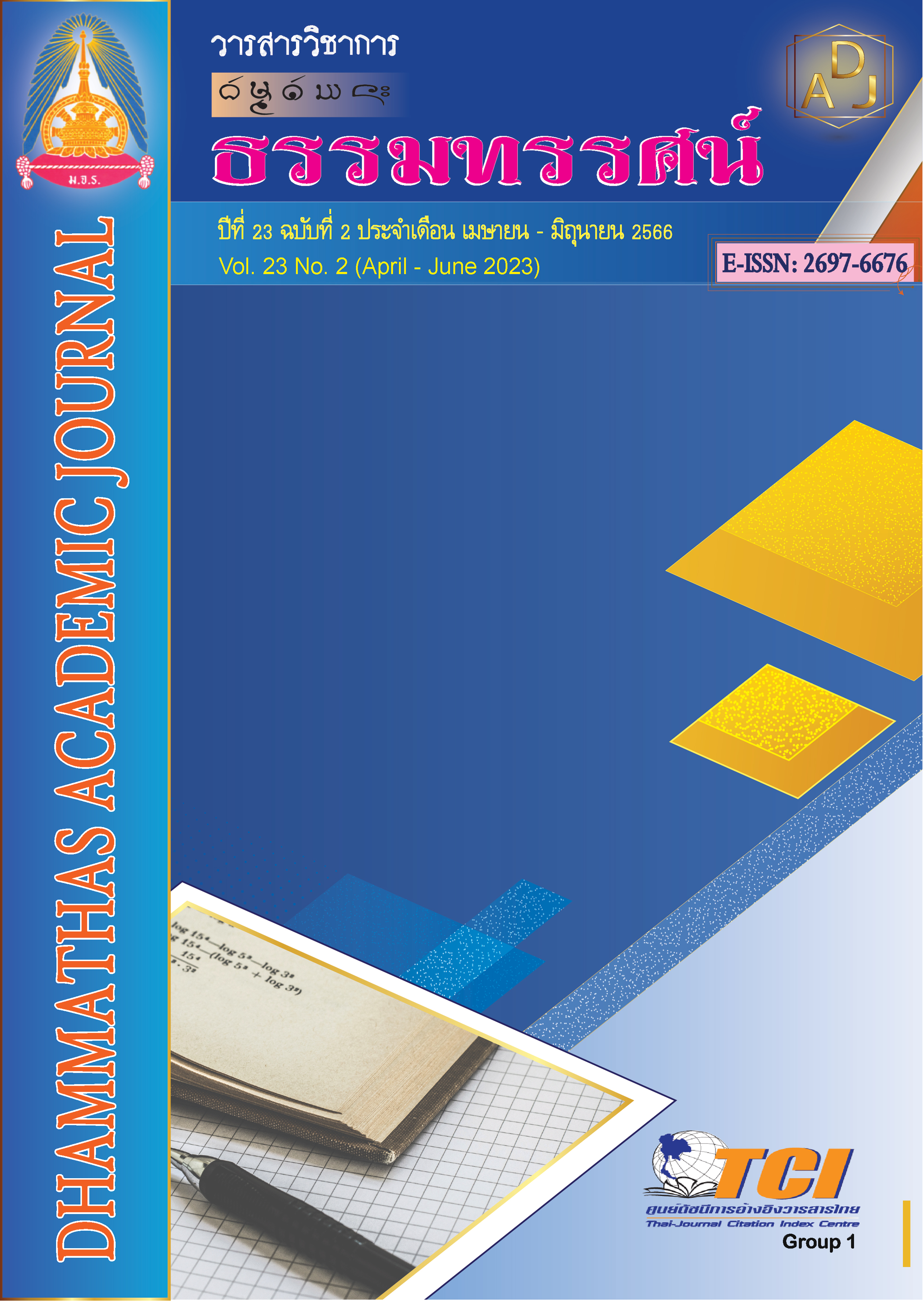Development of Community-based Disaster Management Models in Nakhon Chai Burin
Main Article Content
Abstract
The purposes of this research were 1) to study the problems and impacts of disasters, 2) to study disaster management, 3) to develop the disaster management model, and 4) to propose policy recommendations on community-based disaster management in the Nakhon Chai Burin. This was mixed-method research. The sample included 439 people and 48 key informants from the municipality in Nakhon Chai Burin District. Data were collected through a questionnaire, in-depth interviews, and focus group discussions and analyzed by number, percentage, mean, standard deviation, and content analysis.
The research result finds that:
1. The overall problems and impacts of the disaster were at a high level ( = 4.14, S.D. = 0.18).
2. The overall disaster management was at a high level ( = 3.56, S.D. = 0.30). Preparation before the disaster was at a high level (
= 4.33, S.D. = 0.18). Management during the disaster was at a high level (
= 3.82, S.D. = 0.28), and restoration after the disaster was at a moderate level (
= 3.00, S.D. = 0.30).
3. For a community-based disaster management model, it was found that 1) preparation by planning an adequate budget for management raised awareness, provided knowledge, and regularly practiced based on guidelines. 2) Disaster management was based on an efficient system. 3) Restoration was performed through repair, renovation, and psychological care for victims.
4. Policy recommendations for disaster management included 1) providing necessary manpower and equipment for disaster management, 2) preparing community-based guidelines, 3) building awareness of the disasters in all sectors, and 4) effectively coordinating with network partners.
Article Details

This work is licensed under a Creative Commons Attribution-NonCommercial-NoDerivatives 4.0 International License.
เพื่อให้เป็นไปตามกฎหมายลิขสิทธิ์ ผู้นิพนธ์ทุกท่านต้องลงลายมือชื่อในแบบฟอร์มใบมอบลิขสิทธิ์บทความ ให้แก่วารสารฯ พร้อมกับบทความต้นฉบับที่ได้แก้ไขครั้งสุดท้าย นอกจากนี้ ผู้นิพนธ์ทุกท่านต้องยืนยันว่าบทความ ต้นฉบับที่ส่งมาตีพิมพ์นั้น ได้ส่งมาตีพิมพ์เฉพาะในวารสาร วิชาการธรรม ทรรศน์ เพียงแห่งเดียวเท่านั้น หากมีการใช้ ภาพหรือตารางของผู้นิพนธ์อื่นที่ปรากฏในสิ่งตีพิมพ์อื่นมาแล้ว ผู้นิพนธ์ต้องขออนุญาตเจ้าของลิขสิทธิ์ก่อน พร้อมทั้ง แสดงหนังสือที่ได้รับการยินยอมต่อบรรณาธิการ ก่อนที่บทความจะได้รับการตีพิมพ์References
กรมป้องกันและบรรเทาสาธารณภัย. (2562). สถานการณ์ภัยพิบัติในประเทศไทย. กรุงเทพฯ: กระทรวงมหาดไทย.
กัมปนาท วงษ์วัฒนพงษ์. (2560). การจัดการภัยพิบัติโดยมีชุมชนเป็นฐาน: กรณีศึกษา อำเภอบางระกา จังหวัดพิษณุโลก. รายงานสืบเนื่องการประชุมทางวิชาการของมหาวิทยาลัยขอนแก่น ครั้งที่ 4 การบริหารกิจการสาธารณะภายใต้ประเทศไทย 4.0, 4 สิงหาคม 2560, (หน้า 1718-1730). ขอนแก่น: วิทยาลัยการปกครองท้องถิ่น มหาวิทยาลัยขอนแก่น.
ชูวงศ์ อุบาลี. (2557). การบริหารจัดการภัยพิบัติ: บทบาทขององค์กรปกครองส่วนท้องถิ่นจังหวัดจันทบุรี. วารสารสำนักงานผู้ตรวจการแผ่นดิน, 7(2), 51-69.
ทองใบ เพ็งธรรม และคณะ. (2564). ระบบการบริหารจัดการสาธารณภัยด้านอัคคีภัยเชิงบูรณาการ. วารสารดุษฎีบัณฑิตทางสังคมศาสตร์, 11(1), 230-242.
ธิติรัตน์ เหล่าคมพฤฒาจารย์ และจุลจีรา จันทะมุงคุณ. (2563). การพัฒนารูปแบบการมีส่วนร่วมในการจัดการภัยพิบัติในชุมชน: กรณีศึกษา บ้านบุ่งสิบสี่ ตำบลโนนทอง อำเภอเกษตรสมบูรณ์ จังหวัดชัยภูมิ. วารสารวิชาการมหาวิทยาลัยราชภัฏเพชรบุรี, 10(1), 4-13.
บุญชม ศรีสะอาด. (2553). การวิจัยเบื้องต้น. (พิมพ์ครั้งที่ 8). กรุงเทพฯ: สุวีริยาสาส์น.
สำนักงานสถิติแห่งชาติ. (2563). รายงานสถิติรายปีประเทศไทย พ.ศ. 2563. กรุงเทพฯ: สำนักงานสถิติแห่งชาติ.
สำนักบริหารยุทธศาสตร์กลุ่มจังหวัดภาคตะวันออกเฉียงเหนือตอนล่าง. (2563). แผนพัฒนากลุ่มจังหวัดภาคตะวันออกเฉียงเหนือตอนล่าง 1 (นครราชสีมา ชัยภูมิ บุรีรัมย์ สุรินทร์) ระยะ 5 ปี พ.ศ. 2561-2565 ฉบับทบทวนปี พ.ศ. 2565. นครราชสีมา: สำนักบริหารยุทธศาสตร์ กลุ่มจังหวัดภาคตะวันออกเฉียงเหนือตอนล่าง 1.
เอกราช บุญเริง และคณะ. (2560). การจัดการปัญหาน้ำท่วมของเทศบาลเมืองวารินชําราบโดยชุมชนเป็นศูนย์กลาง: กรณีศึกษา 14 ชุมชนที่ได้รับผลกระทบจากปัญหาน้ำท่วม. วารสารการบริหารท้องถิ่น, 10(4), 24-39.
Aleksi R., et al. (2020). Conceptualizing community in disaster risk management. International Journal of Disaster Risk Reduction, 45, 1-8.
Alrehaili, N. R., et al. (2022). A Structural review on disaster management models and their contributions. International Journal of Disaster Management, 5(2), 93-108.
Asia-Pacific Disaster Report. (2017). Disaster resilience for sustainable development. Retrieved from https://www.unescap.org/publications/asia-pacific-disaster-report-2017-leave-no-one-behind
Azad, M. A. K., et al. (2019). Community-based disaster management and its salient features: A policy approach to people-centred risk reduction in bangladesh. Asia-Pacific journal of rural development, 29(2), 135-160.
Baharmand, H., Comes, T., and Lauras, M. (2020). Supporting group decision makers to locate temporary relief distribution centres after sudden-onset disasters: A case study of the 2015 Nepal earthquake. International Journal of Disaster Risk Reduction, 45, 1-21.
Blaikie, P., et al. (2003). At risk: Natural hazard, people’s vulnerability and disaster. (2nd ed.). London: Routledge.
Coenraads, R. (2006). Natural disasters and how we cope. Rowville, Vic: Five Mile Press.
Cronbach, L. J. (1984). Essentials of psychological testing. (4th ed.). New York: Harper & Row.
Department of Disaster Prevention and Mitigation. (2014). National disaster prevention and mitigation plan (2010-2014). Bangkok: Office of National Buddhism press.
Pandey, B., and Okazaki, K. (2005). Community based disaster management: Empowering communities to cope with disaster risks. Retrieved from http://unpan1.un.org/intradoc/groups/public/documents/un/unpan020698.pdf
Putnam, H. (1997). A half century of philosophy, viewed from within. Daedalus, 126, 175-208.
The United Nations office dedicated to Disaster Risk Reduction. (2019). Annual Report 2019. Switzerland: Geneva.
UNISDR. (2015). Disaster risk reduction and resilience in the 2030 agenda for sustainable development. Retrieved from http://www.unisdr.org/files/46052_disasterriskreductioninthe2030agend.pdf
Yamane, T. (1973). Statistics: an introductory analysis. (3rd ed.). New York: Harper & Row.

